Keine Berührungsängste (No Fear of Contact)
Thomas Wulffen in dialogue with Wolfgang Polak from the Centre for Art Exhibitions of the GDR, on May 10, 1990

"The most important institution for the international dissemination of art from the GDR was the Centre for Art Exhibitions (Zentrum für Kunstausstellungen, ZfK), which was founded in East Berlin in 1973, initially under the name New Gallery of Berlin – Centre for Art Exhibitions (Neue Berliner Galerie – Zentrum für Kunstausstellungen)."
The work of the Centre for Art Exhibitions
The GDR Centre for Art Exhibitions (Zentrum für Kunstausstellungen der DDR, ZfK) was founded in 1973 as a state institution for scholarship and art. It issued from the former "Exhibition Group" (Ausstellungsgruppe) of the Ministry for Culture (Ministerium für Kultur), which had been created in 1959. The organisation worked reciprocally – it planned, organised, and mounted interdisciplinary exhibitions both at home in the GDR and abroad. The exhibitions in the ZfK Galleries presented art from abroad in the GDR, but also art from the GDR around the world. The ZfK was under the oversight of the GDR’s Ministry for Culture and had the mission of furthering artistic exchange around the world. In developing and carrying out its projects, which were exhibited not only in Socialist “Sister countries,” but also in the so-called “Western foreign countries,” the institution worked closely together with the GDR’s Association of Visual Artists (Verband Bildender Künstler, VBK).
The ZfK ran several exhibition spaces. The Neue Berliner Galerie, through 1975, had extensive exhibition space in Berlin’s Marstall. From 1976 to 1990, it offered an international program in the Altes Museum on the Museumsinsel. From 1979 on, the ZfK added the Galerie am Weidendamm, a pavilion building located across the street from the so-called "Tränenpalast", Exit hall of the border crossing point at Friedrichstraße station. In 1984, the ZfK began its work in Dresden’s Galerie Rähnitzgasse, and in 1989/90 it began planning to create a new Kunsthalle in the Deutscher Dom on the Gendarmenmarkt. The ZfK’s primary mission was soon defined as the presentation of art abroad. This included organising the GDR’s participation in the Biennale of São Paulo and Venice, as well as in documenta 6 and 7.
The numbers speak for themselves: The ZfK, in 1989, had a total of 95 formal posts, occupied by 80 employees distributed over the departments of Fine Arts, Applied Arts, Poster Art, and Stage Design. It organised as many as 130 exhibitions per year, of which between 50 and 80 involved collaboration with partner institutions abroad. At the same time, the ZfK published catalogues to accompany the exhibitions and, from 1977 to 1988, its own newsletter, called Mitteilungen, of which nine issues appeared.
The texts that follow aim to provide an insight into the structure and work of the ZfK. They mark the beginning of an ongoing research project initiated by the ifa and made possible through a cooperation with the Wüstenrot Stiftung.
International Visibility
In the issue Mitteilungen 2 from 1978, one reads that the ZfK was able to realise more than 130 exhibitions that year. Artists from the GDR participated in more than 20 international Biennale and Triennale for graphic art:
"A representative exhibition, 'Realistic German Art', was presented at the beginning of 1978 in Vienna. In this extensive show, there were works of Max Beckmann, Hans Grundig, Käthe Kollwitz, Max Lingner, Otto Nagel, Curt Querner, Johannes Wüsten, and many other artists. Artists from the northern regions of the GDR provided insight into their current work in Finland. In London, stage designs and a selection from the Museum of Toys in Sonneberg were presented.
Should we wish to complete the list of countries in which exhibitions organised by the Centre for Art Exhibitions were shown in 1978, the following excerpts will give you an idea of just how broad an arc would have to be traced: Czechoslovakia, Poland, Rumania, Hungary, Cuba, Yugoslavia, Belgium, West Germany, Denmark, France, Iceland, Luxembourg, the Netherlands, Norway, Portugal, Sweden, Switzerland, Spain; not to mention the exhibitions in West Berlin. There were also Australia, Japan, Canada, and the USA. Turkey, Iraq, Iran, Cyprus, Egypt, Syria, Bangladesh, Burma, India, Laos, Malaysia, Nepal, and Pakistan expand the picture. Moreover: Algeria, Tunisia, Angola, Benin, Ghana, Guinea-Bissau, the Congo, Mali, and Chad. And last but not least: Argentina, Brazil, Columbia, Mexico, Peru, and Venezuela."
Source: "Aus der Arbeit des Zentrums für Kunstausstellungen der DDR" (From the Work of the GDR Centre for Art Exhibitions), in: Mitteilungen 2 / Zentrum für Kunstausstellungen der DDR, published by the GDR Centre for Art Exhibitions – Publicity Department, 1978, p. 2.
Mitteilungen 2 / Zentrum für Kunstausstellungen der DDR, published by the GDR Centre for Art Exhibitions – Publicity Department, 1978.
From 1977 on, the ZfK published the magazine Mitteilungen, in which the work of the institution, certain exhibitions, and the work of selected international artists were presented.
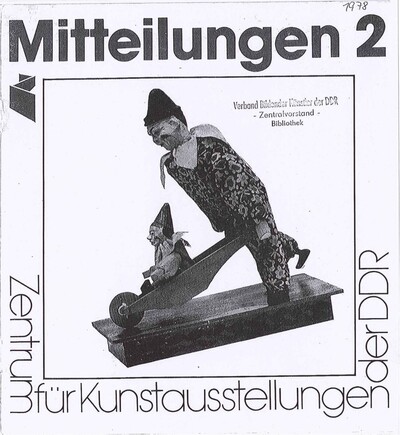


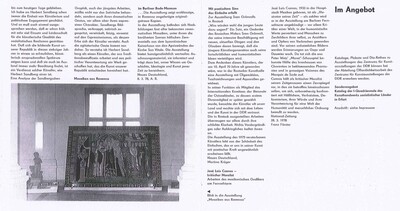


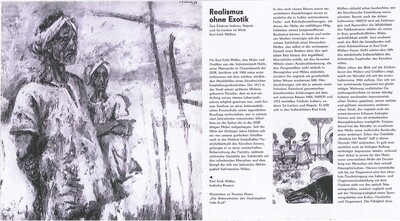
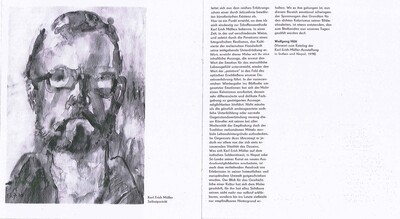
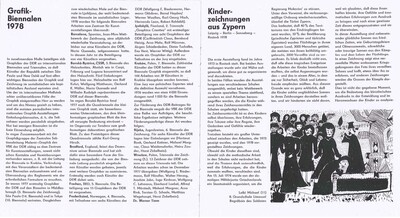
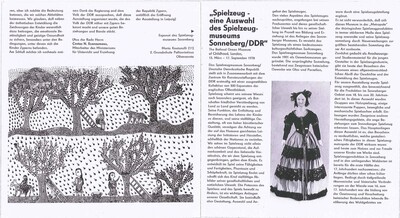
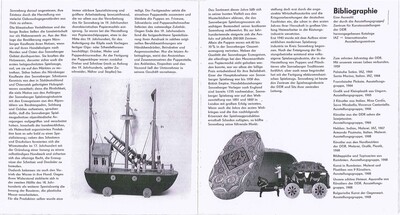
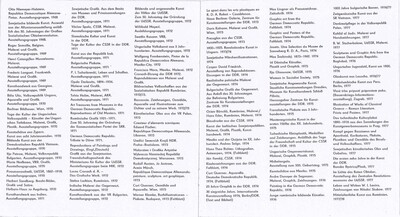
"Evenings in the Seagull": Rolf Krickow in dialogue with Dr Georg Schneider
In the central club of the Artists‘ Union, Die Möwe (the Seagull), Rolf Krickow spoke with Georg Schneider, Director of the GDR Centre for Art Exhibitions, about his career path, the mission of the ZfK, and upcoming projects. The interview constituted the 59th instalment of the series "Abends in der Möwe" (Evenings in the Seagull) and was broadcast on April 2, 1980.
Rundfunk der DDR 1980 © Deutsches Rundfunkarchiv (DRA) Babelsberg, Archivnummer 3M12981
The GDR Centre for Art Exhibitions and the Art Exhibitions of the GDR
Dresden was the site of the Art Exhibitions of the GDR, a festival that took place every five years between 1946 and 1988. At the centre of the photographs selected here are people, and thus the public for the ninth edition of the festival, held from October 2, 1982 through April 3, 1983, visited by around a million citizens. The ZfK had a branch in the Galerie Rähnitzgasse starting in 1984, and organised from that site the VIIIth, IXth, and Xth editions of the Art Exhibitions of the GDR. The IXth edition presented works of nearly 1 500 artists in the Albertinum, the Pretiosensaal of the Dresden Castle, and in the halls of the Ausstellungszentrum am Fučíkplatz.
The photo series Zeitreise (A Voyage in Time) by Christian Borchert spans a time period from 1954 to 1995. It is dedicated to the city of Dresden, where he was born, and where the artist returned again and again, although living at the time in Berlin-Pankow. Borchert (1942–2000), who counts among the most prominent figures of East Germany’s photography scene, was a sensitive observer of his times.
57 original prints of photographs by Christian Borchert from the series Künstlerporträts (Artist Portraits), once held in the inventory of the ZfK, are now in the custody of the ifa. In the course of nearly two years, Borchert photographed over 200 artists in der GDR – painters, sculptors, film-makers, composers, and writers – and thus captured many unique impressions of the East German cultural scene in the 1970s.
Mirror of Culture: "15 Years of the GDR Centre for Art Exhibitions" – A Radio Report
On the occasion of the ZfK’s 15th anniversary celebrations, the journalist Inge-Lore Bellin spoke in the radio studios (Funkhaus) in the Nalepastraße in Berlin-Köpenick with Dr Wolfgang Polak, Director of the ZfK, about the history and work of the Centre.
Rundfunk der DDR 1988 © Deutsches Rundfunkarchiv (DRA) Babelsberg, Archivnummer 2009565
Likewise in connection with the anniversary of the ZfK, Mitteilungen 9 appeared. This issue of the magazine contained, among other things, an article by Dr Wolfgang Polak, in which he summed up the activity of the ZfK over the previous 15 years and gave an insight into its future planning. As it turned out, however, this was to be the last issue of the Mitteilungen.
Mitteilungen 9 / Zentrum für Kunstausstellungen der DDR, published by the GDR Centre for Art Exhibitions – Publicity Department, 1978.
The ninth issue of the Mitteilungen was devoted to celebrating the 15 years of ZfK’s existence. This issue turned out to be the last. Nevertheless, it provides a broad insight into the history and structure of the ZfK.
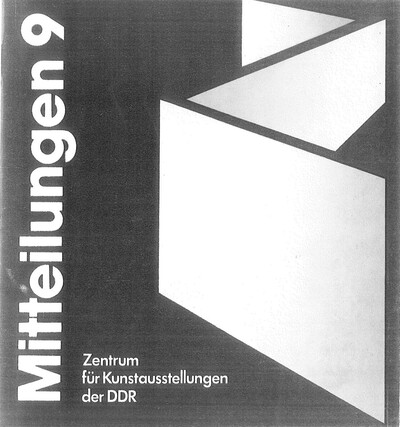
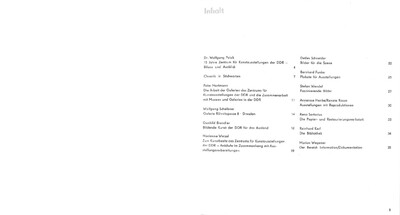
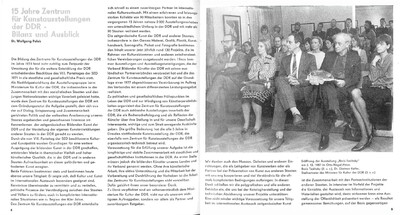

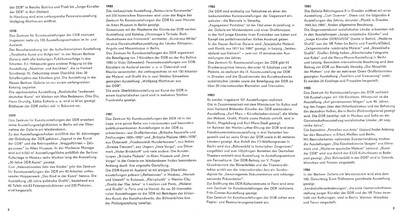
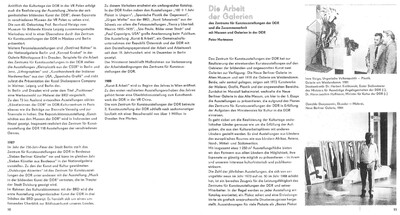
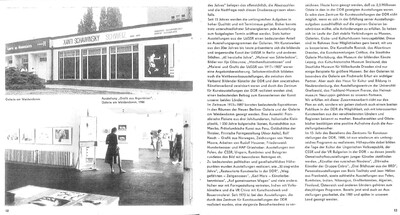


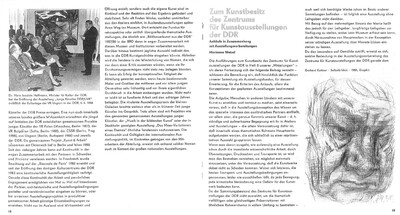

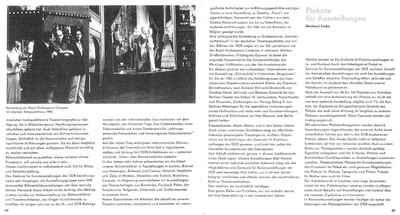
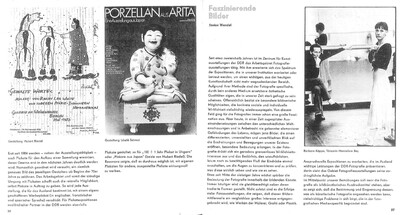

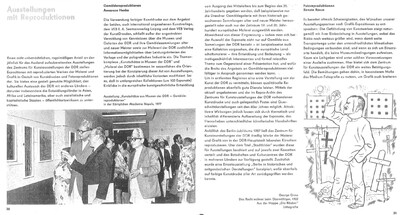
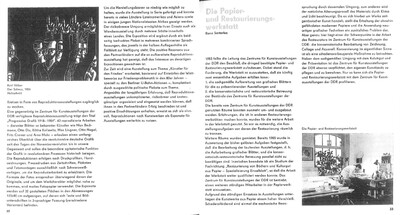
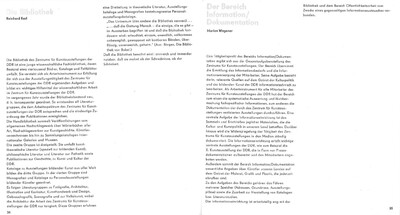
The Year 1990
With the fall of the Wall, the ZfK in 1990, on the one hand, saw new horizons open up in the scope of its work – thus it was possible, for instance, to realise the Rauschenberg Overseas Culture Interchange (ROCI), a project with Robert Rauschenberg, in the Neue Galerie. On the other hand, reunification was to bring with it a process of profound societal and political reorganization, as the institution’s employees foresaw. Hans-Jörg Schirmbeck is in a position to report the following concerning the work of the ZfK in its final year of existence:
"And last, but not least, 1990 saw the realization of exhibitions that would never have been possible in 1989."
According to Schirmbeck, several significant art exhibitions were organized with the participation of the state, after an arduous process of obtaining the approval of the GDR’s Ministry of Culture: Robert Rauschenberg was exhibited in the Neue Berliner Galerie, and Wolf Vostell brought his enormous triptych 9. November 1989 from his studio in West Berlin (Am Käuzchensteig) into the Galerie am Weidendamm. Vostell’s exhibition would never have been possible without the advance lobbying work of the internationally networked mail-art-practitioner from Pankow, Robert Rehfeldt. At the same time, the US-American pianist and composer John Cage, an exceptional figure in the music of the 20th century, gave a concert in the East-Berlin Academy of Arts. The two artists came together at an art festival on the Kollwitzplatz in Prenzlauer Berg.
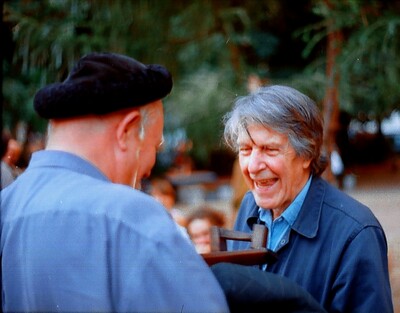
Wolf Vostell (left) and John Cage at the Kollwitzplatz Festival, 1990. Photo: Archiv Schirmbeck
With the dissolution of the GDR, it was decided, despite public criticism and heated debate, to close the GDR Centre for Art Exhibitions. It officially ceased operations as of December 31, 1990. The ifa, with seat in Stuttgart, which had up to that time functioned as the West German equivalent of the ZfK, was entrusted with carrying on this part of the foreign cultural policy of a reunified Federal Republic of Germany. An interim organization, the Society for Art Exhibitions (Gesellschaft für Kunstausstellungen mbH, or GFK) was created to mount exhibitions already in planning. It operated from 1990 to 1992. The desire many felt to continue the work of the ZfK with the GFK as exhibiting institution was ultimately disappointed, owing to the lack of political will and financing.
The mission of the ZfK was comparable to that of its West German equivalent, the ifa. Both institutions supported the art scene in their respective countries, organised exhibitions abroad, and invited artists from all over the world to the two Germanies. The ifa continues even today, as mediating agency for foreign cultural and educational policy, to foster international exchanges in the fields of art and culture by organising touring exhibitions, presenting a gallery program in both Berlin and Stuttgart, offering stipends for artists and exhibitions, and curating the German Pavilion in Venice.
No Fear of Contact
"You might as well just erase the designation 'GDR', given the general trend right now …"
Thomas Wulffen in dialogue with Dr Wolfgang Polak
T.W.: Could you describe the purpose and working methods of the GDR Centre for Art Exhibitions before and after the 9th of November?
W. P.: At the outset, let me tell you what does not need to change. We have always been an institution dedicated to exchanges of art exhibitions. We have sent exhibitions from the GDR abroad and shown foreign exhibitions here in East Germany. With regard to the latter – that is, mounting foreign exhibitions here – there is formally speaking no reason why anything needs to change following the 9th of November. There is a very valid question concerning the dissemination abroad of art from the GDR, for the very name of our institution already evokes a certain political program. You might as well just erase the designation 'GDR', given the general trend right now …
The Abrupt End of the GDR Centre for Art Exhibitions
"As representatives of the GDR’s cultural policy, they [the staff of the ZfK] made an effort, primarily in the 'Western' foreign countries, to present the art of the GDR in such a way as to include in its representative program a certain number of artists who were under attack from the cultural bureaucracy and therefore could no longer be seen in East Germany."
Müller, Katrin Bettina. "Kunstentzug" (Art Withdrawal), in: Berliner Kunstblatt, No. 69, 1990, pp. 14–16.
In the run-up to her article "Art Withdrawal", Katrin Bettina Müller published in the taz (one of Berlin’s daily newspapers) two preliminary articles on the project for a Kunstforum Deutscher Dom (Cultural Forum in Berlin’s German Cathedral) that had been co-initiated by the ZfK.
Müller, Katrin Bettina. "Die Geheimnisse des Deutschen Doms" (The secrets of the German Cathedral), in: taz am Wochenende, 10.03.1990, p. 36, https://taz.de/!1777106/.
Katrin Bettina Müller. "Dem Deutschen Dom droht Baustopp" (Renovation of the German Cathedral may be stopped), in: taz. die tageszeitung, 2.11.1990, p. 21, https://taz.de/!1745730/.


The ZfK, German Reunification, and the ifa
Nora Kaschuba and Jule Lagoda
The GDR’s accession to the Federal Republic of Germany on October 3, 1990, entailed – not least of all – a fundamental transformation of the East German cultural landscape. The ZfK had for over 17 years shaped the exhibition activities of the GDR and could look back over an impressive record of mounting as many as 130 exhibitions per year, in the GDR and abroad, as well as organising a diverse series of cultural events.[1] From an organisational and financial point of view, the ZfK answered to the Ministry of Culture – and the Ministry of Culture, like other central political agencies of the GDR, was dissolved in connection with German Reunification.[2] What, then, was to happen with the ZfK?
It was clear that the reunified Germany would want to have a presence abroad by participating in international art exhibitions and to help shape global exchanges in the field of culture. With the ifa in Stuttgart, there was a West German equivalent to the ZfK, which, structurally dependent on the FRG’s Foreign Service (Auswärtiges Amt), promoted international cultural-political relationships.[3] The question now was how the work of the two institutions could be merged.
The basic guidelines for the union of the two German states were laid down in the Reunification Treaty of August 31, 1990. This Treaty stipulated, among other things, that centrally administered East German cultural institutions would be either incorporated into the provincial administration of one or more of the reunified Germany’s new Bundesländer in the former East – or liquidated.[4] There was in most cases no provision for a continued financing of such institutions by the federal government. This applied to the ZfK, as well: In September 1990, the last Minister of Culture for the GDR, Herbert Schirmer, issued instructions to the effect that the Centre for Art Exhibitions should be dissolved as of the end of the year and that all employees were to be dismissed.[5] The unwinding of the organisation was carried out, through a legally intricate process, by the Federal Ministry of the Interior (Bundesinnenministerium), the Senate of Berlin (Berliner Senat), and the Joint Institution of the Bundesländer – Culture (Gemeinsame Einrichtung der Länder – Kultur, or GELK).[6]
This procedure was accompanied by hefty controversy. Many employees of the ZfK wanted to continue pursuing their cultural-political ideas and exhibition plans...

"Rest in Peace!" – sticker, designed by staff members of the ZfK. Photo: Archiv Polak
Looking Back on the Work of the GDR Centre for Art Exhibitions:
Hans-Jörg Schirmbeck and Peter Hartmann
The Scope of Activities of the Centre for Art Exhibitions
Hans-Jörg Schirmbeck, former director of the Department of Exhibitions, reported in his talk at the Max Lingner Stiftung on May 10, 2023, on the work of the ZfK. He emphasized that the institution, during the period of its existence from 1973 to 1990, organised hundreds of exhibitions. In 1978 alone, the number of exhibitions totalled more than 130. Altogether, it is estimated that 130 000 visitors saw the ZfK’s exhibitions not only in Berlin, but also in Rostock, Dresden, Erfurt, Leipzig, and other cities.

"Das Zentrum für Kunstausstellungen der DDR. Internationale Kunstausstellungen im Staatsauftrag und gegen das provinzielle Denken der offiziellen DDR-Kunstpolitik" (The GDR Centre for Art Exhibitions. International art exhibitions under the aegis of the state and in spite of the provincial thinking of official GDR art policy), lecture by Hans-Jörg Schirmbeck, followed by a discussion with Christian Saehrendt.
The GDR Centre for Art Exhibitions
Hans-Jörg Schirmbeck
The mission of the GDR Centre for Art Exhibitions (Zentrum für Kunstausstellungen der DDR, ZfK), starting in 1973, consisted in furthering international cultural exchanges – in particular in representing the art of the GDR abroad and presenting international art in East Germany. Through exhibitions, concerts, and theatre productions, the Centre sought to promote international recognition of the GDR in the sphere of cultural politics. The ZfK ceased operations as of December 31, 1990, pursuant to a resolution of the last Ministry of Culture for the GDR. The Institut für Auslandsbeziehungen der Bundesrepublik Deutschland (ifa) had at the time, and continues to pursue today, a mission comparable to that of the ZfK. The ifa in 1991 assumed the duties as well as a part of the art collection of its equivalent institution in the GDR.
Institutional history of the ZfK, its working methods, and its impact both domestically and abroad in the 1970s and 1980s
The ZfK, during the period of its existence from 1973 to 1990, organized exhibitions on a prodigious scale. Between 1973 and 1983 alone, over 1 000 exhibitions …
the complete publication by Hans-Jörg Schirmbeck
International exhibitions in der GDR
The project Art in Networks – The GDR and Its Global Relations at the TU Dresden, under the supervision of Prof Kerstin Schankweiler, investigates the international relationships between the GDR and various countries in Africa, Asia, and Latin America. Its online platform renders the resulting international networks visible and, with a timeline and numerous interviews, brings into focus the cultural-political events and personal contacts.
Peter Hartmann, in a video interview titled "International exhibitions in the GDR – Working at the ZfK" reports on his time as head of the Press and Publicity Department and as Director of the Neue Berliner Galerie from 1975 to 1990.
"The ZfK showed art that did not really fit into official canon of GDR art or into the official understanding of what art was meant to do. That art was nevertheless shown, because the GDR at the time wanted to say: Hey, everybody, look here, how open-minded we are!"
Further Sources on the GDR Centre for Art Exhibitions
Akademie der Künste Berlin (Academy of Arts Berlin)
The data bank of the Academy of Arts (Akademie der Künste) in Berlin furnishes an overview of the archives of the GDR’s Association of Visual Artists (Verband Bildender Künstler, VBK), conserved by the Association of Art Historians and Art Critics (Kunstwissenschaftler- und Kunstkritikerverband). Twenty files relevant to the history of the ZfK are conserved there, for instance those on preparations for the Xth Art Exhibition of the GDR (X. Kunstausstellung der DDR) or on the cooperation agreements between the ZfK and the VBK. Also conserved in the Academy of Arts is the photograph collection of the ZfK, which documents in over 10 000 photographs art works from the period 1954 to 1990.
Bundesarchiv Berlin (Federal Archives in Berlin)
Because the GDR Centre for Art Exhibitions belonged to the structure of the Ministry of Culture, many relevant files are now held in the Federal Archives (Bundesarchiv) in Berlin. Thus, for instance, the portfolio marked "DR 123 – Zentrum für Kunstausstellungen der DDR" (DR 123 – GDR Centre for Art Exhibitions), which covers the period from 1959 to 1990. The fact that this portfolio does not begin with the period around the founding of the ZfK in 1973 is owing to the bundling of the ZfK files with those of the Exhibition Group (Ausstellungsgruppe) of the GDR Ministry of Culture. A spot check of these holdings made it clear that these 613 files contain primarily documentation (press reports, press releases, printed matter). Further, the "Final Report on Termination of the Activities of the Centre for Art Exhibitions as of December 31, 1990" (Abschlussbericht über die Beendigung der Tätigkeit des Zentrums für Kunstausstellungen zum 31.12.1990), filed with the Staff Service Reports (Dienstakten) of the Bundesarchiv, provides information on the winding up of the ZfK.
Kunstarchiv Beeskow/Museum Utopie und Alltag (Art Archive Beeskow/Museum of Utopia and Everyday Life)
In the city of Beeskow is located the so-called Leber Collection (Sammlung Leber), which exists thanks to the initiative of ZfK staff member Dieter Leber. Leber saved an archive of posters held in the Bode Museum from being discarded in the wake of reunification. The collection contains, besides posters of the ZfK, also posters from other art exhibitions of the GDR. One can obtain an overview of the Collection from a list made available by the Art Archives Oder-Spree (Kunstarchiv Oder-Spree), which catalogues a total of 7 148 objects.
Stadtarchiv Dresden (Municipal Archives of Dresden)
In Dresden’s Neustadt, the ZfK operated, from 1984 on, the Galerie Rähnitzgasse, which still exists today as the Kunsthaus Dresden. In the Municipal Archives (Stadtarchiv) of Dresden, the files of the Kunsthaus Dresden are held together with those of the Galerie Rähnitzgasse from the GDR era. The date markings indicate that, of these files, 176 are potentially of relevance for the history of the ZfK.
Zentralarchiv der Staatlichen Museen zu Berlin (Central Archives of the Federal Museums of Berlin)
The ZfK’s Neue Berliner Galerie was located in the Altes Museum. In the holdings of the Central Archives of the Federal Museums of Berlin (Zentralarchiv der Staatlichen Museen, inter alia in the files pertaining to the National Gallery – East [Nationalgalerie – Ost] and the Directorate General [Generaldirektion]), there are nearly 70 files on the work of the ZfK. The date markings on the files run from the era of the Ministry of Culture’s Exhibition Group around 1960 through the liquidation of the ZfK in 1990.
Brandenburgisches Landesmuseum für moderne Kunst (BLMK) (Brandenburg’s Provincial Museum for Modern Art)
In 1998, the ifa Gallery Berlin offered Brandenburg’s Provincial Museum for Modern Art (Brandenburgisches Landesmuseum für moderne Kunst, BLMK) a part of the ZfK’s poster collection as a gift. The inventory included nearly 3 000 posters and in large part has yet to be catalogued. Among the 439 posters catalogued to date, there are, in addition to exhibition posters, also posters advertising theatre and political events, as well as some posters from Japan.
Research on sources: Schumm, Richard. Vorstudie zu den Archivquellen des ifa und ZfK (Preliminary Study on Archival Sources for the ifa and ZfK), Stuttgart 2022.
Research on the history and work of the ZfK and that part of its Art Collection now held by the ifa was made possible through a cooperation with the Wüstenrot Stiftung. The research is being conducted under the oversight of Susanne Weiß (Curator of the Art Collection, ifa) in collaboration with Hans-Jörg Schirmbeck, former director of the Exhibitions Department of the ZfK, the art historians Nora Kaschuba and Jule Lagoda, as well as Tina Weingardt (Collection Manager, ifa) and Paulinus Burger (Research Assistant, ifa). The curator and art historian Elke Neumann acts as special advisor to the project. Textual editing: Holger Steinemann. Translation: Darrell Wilkins.

More on the GDR Centre for Art Exhibitions: